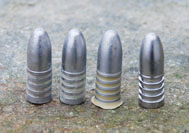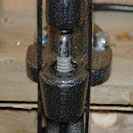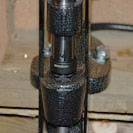Forum
Market
- Nydelig publisert Webley No. 5 Army Express
- Engelsk pattern 1751 infanteri sabel
- Engelsk spadroon
- Winchester High Wall 38-55
- Smith & Wesson model 2.
- Kjøper Engelske millitære flintlåsvåpen
- " Hevarm " til Kongsberg kammerlader
On this day
26 October 1811
The Danish-Norwegian frigate Najaden was launched. Najaden was built in 1811 and equipped with 36 cannons. Later it was upgraded to 42 cannons. The frigate's career was short-lived: It was sunk during the Battle of Lyngør on 6 July 1812 by the... Read more ...
The frigate Najaden was set afloat
The Danish-Norwegian frigate Najaden was launched. Najaden was built in 1811 and equipped with 36 cannons. Later it was upgraded to 42 cannons. The frigate's career was short-lived: It was sunk during the Battle of Lyngør on 6 July 1812 by the British ship of the line HMS Dictator . Najaden was then under the command of Captain Hans Peter Holm.

Chat
Offline
No chatting right now.
(You must be logged in to the forum to chat.)
Featured article

In order to load match-grade black powder cartridges it is important to compress the powder. This allows for more powder in the case, as well as improved combustion and accuracy. This article shows how you can make a sturdy drop tube stand with simple tools.
Make your own drop tube stand
Useful Reloading Equipment
 About
About Les artikkel på norsk
Les artikkel på norskThere is a lot of available reloading equipment for the black powder cartridge shooter. Much of it is for the especially interested shooters and most ordinary shooters can do without too much equipment. However, reloading equipment is fun and in many cases it can be time-saving. It may even enhance accuracy.
Bullet casting
Most black powder shooters cast their own bullets. Muzzleloader shooters usually cast pure lead bullets, while black powder cartridge shooters often prefer to add some tin in the alloy to increase the hardness of the bullets. A common alloy is 1:20 or 1:30 tin/lead. One of my best investments regarding bullet casting is a lead thermometer that measures the lead temperature in the casting pot. Even temperature is a prerequisite for even bullets. This means less discarded bullets and you use less time to cast the bullets you need.When I cast pure lead bullets I use the max temperature of the melting pot which is over 1000 Fahrenheit (about 540 Celsius). When I use tin alloys I cast at a temperature of about 750 Fahrenheit (about 400 Celsius). The reason is that the tin in the alloy may evaporate at higher temperatures.
Lead thermometers for bullet casting are produced by, for example, Lyman and RCBS, and can be bought where you buy reloading equipment. Tin alloys can be bought from suppliers of black powder reloading equipment, such as Buffalo Arms.
Find out more!
You can learn more about reloading equipment and accessories for black powder guns in the brand new book From Musket to Metallic Cartridge: A Practical History of Black Powder Firearms.
Lubricating bullets
Cast bullets must be lubricated. There are many different ways of lubricating bullets. The most primitive method is to lube them by hand, which means applying bullet lube into the grease grooves with your fingers. This works ok, but it is messy and time consuming.
Another method is to dip the bullets in molten bullet lube. I have used this method a lot, and it works well. You melt the bullet lube in a double boiler, use pliers to dip the bullets in the lube and set them aside to dry on, for example,on a sheet of newspaper. You can also 'bath'a number of bullets in molten lube and pick them up with pliers and dry them. This method is also messy, and if the lube is too hot the lube will not stick to the greasing grooves when drying. The opposite may also happen: if the bullet is too cold it have too much lube. The latter doesn't matter if you size the bullet after lubricating as excess lube will be removed when sizing. The advantage with this method is that it is relatively fast.
You can also melt bullet lube in a double boiler: place the bullets standing up in tray and pour the molten bullet lube in the tray until the top grease grooves are covered. Let the bullet lube cool and harden. When you remove the bullets the grooves are covered with lube.
Many shooters use a lube sizer to lube and size the bullet in one operation. If you don't want to size the bullet you can simply use a sizing die which has the same diameter as the bullet you are lubricating. Lube sizers are fast and not near as messy as the other methods described. You can use commercial lubricants such as SPG, Lyman Black Powder Gold or White Lightnin, or you can use your own home-made lubricant. If your bullet lube is stiff and hard it may be an advantage to invest in a heating element. The new 4500 Lubrisizer from Lyman has a smart solution where the heating element is a plug which is inserted into the press. You should not need a heating element when using black powder lubricants, but it may be a good investment, especially during the winter.
Yet another advantage with a lube sizer is that you can adjust how many grooves you want to lubricate. However, a lube sizer is a bit expensive, and it cannot lube heel-based bullets. Sixing dies over .50 calibre is not commercially available, but you can have them custom made up to at least .58".
Wad punch for the reloading press
Most black powder cartridges are loaded with some sort of wad. The wad material varies, but the most common materials are fibre, felt or cardboard. The most common is to make them with a traditional wad punch. This has worked for me for many years, but a while ago I came across a simple tool wad punching tool that is inserted into a reloading press. With this simple tool you can produce thousands of wads per hour. But the best of all is the quality of the wads. Wads punched with this tool are sharp edged, even and perfectly round. Until now I have one in .45 calibre, but they are also available in .50 and .40. Got to have some of those as well.
Grease cookies
If you shoot paper patched bullets you probably use a grease cookie behind the bullet. These cookies can be hard to make because you want the thickness to be as even as possible. A common method is to use a rolling pin to flatten a piece of bullet lube and punch the wads out with the case. Using the rolling pin method is time-consuming and messy. But, there are tools that can do this job as well. There are two different versions available: one that is inserted into a lube sizer and another which is mounted in a reloading press. I have the lube sizer version, and the tools spits out a strip of bullet lubricant which is about .45" wide and of even thickness, which means that it can be only be used for .45 calibre and below. The reloading press tool produces a slightly wider and thicker lube strip. You can find both at Buffalo Arms.
Simple and traditional reloading tools
In the old days hand-held reloading tools were used instead of the stationary reloading presses we are used to today. Lyman still manufacture the hand-held reloading 310 Tool that was made for the first time over 100 years ago. It was 'nutcrackers' like this that were used by the buffalo hunters that hunted buffalo on the American plains during the 1870s and 1880s.
The Lyman 310 Tool makes it easier to reload at the range or in the field. The tool handles are made in a large and a small version. Dies must be purchased separately. A set of dies contains a neck resizing and decapping die, primer seating chamber, neck expanding die, bullet seating die and case head adapter. Pistol size cartridge dies use the small handles, while rifle dies must have large handles. The only thing I miss is a powder compression die, but that should be relatively easy to make.
The 310 Tool is available for all the classical American rifle and pistol calibres. All the things that are described in this article can be purchased from Buffalo Arms.













